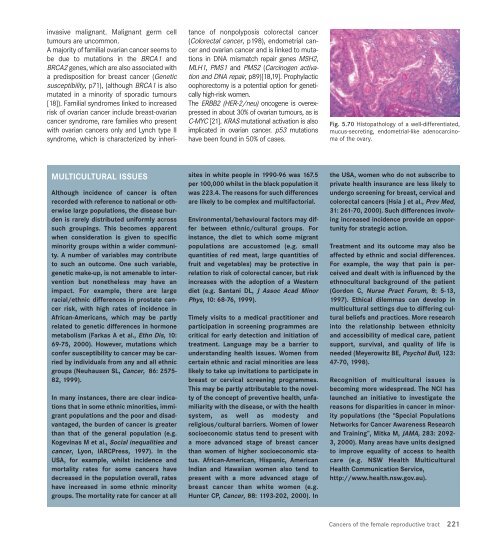world cancer report - iarc
world cancer report - iarc
world cancer report - iarc
Create successful ePaper yourself
Turn your PDF publications into a flip-book with our unique Google optimized e-Paper software.
invasive malignant. Malignant germ cell<br />
tumours are uncommon.<br />
A majority of familial ovarian <strong>cancer</strong> seems to<br />
be due to mutations in the BRCA1 and<br />
BRCA2 genes, which are also associated with<br />
a predisposition for breast <strong>cancer</strong> (Genetic<br />
susceptibility, p71), (although BRCA1 is also<br />
mutated in a minority of sporadic tumours<br />
[18]). Familial syndromes linked to increased<br />
risk of ovarian <strong>cancer</strong> include breast-ovarian<br />
<strong>cancer</strong> syndrome, rare families who present<br />
with ovarian <strong>cancer</strong>s only and Lynch type II<br />
syndrome, which is characterized by inheri-<br />
MULTICULTURAL ISSUES<br />
Although incidence of <strong>cancer</strong> is often<br />
recorded with reference to national or otherwise<br />
large populations, the disease burden<br />
is rarely distributed uniformly across<br />
such groupings. This becomes apparent<br />
when consideration is given to specific<br />
minority groups within a wider community.<br />
A number of variables may contribute<br />
to such an outcome. One such variable,<br />
genetic make-up, is not amenable to intervention<br />
but nonetheless may have an<br />
impact. For example, there are large<br />
racial/ethnic differences in prostate <strong>cancer</strong><br />
risk, with high rates of incidence in<br />
African-Americans, which may be partly<br />
related to genetic differences in hormone<br />
metabolism (Farkas A et al., Ethn Dis, 10:<br />
69-75, 2000). However, mutations which<br />
confer susceptibility to <strong>cancer</strong> may be carried<br />
by individuals from any and all ethnic<br />
groups (Neuhausen SL, Cancer, 86: 2575-<br />
82, 1999).<br />
In many instances, there are clear indications<br />
that in some ethnic minorities, immigrant<br />
populations and the poor and disadvantaged,<br />
the burden of <strong>cancer</strong> is greater<br />
than that of the general population (e.g.<br />
Kogevinas M et al., Social inequalities and<br />
<strong>cancer</strong>, Lyon, IARCPress, 1997). In the<br />
USA, for example, whilst incidence and<br />
mortality rates for some <strong>cancer</strong>s have<br />
decreased in the population overall, rates<br />
have increased in some ethnic minority<br />
groups. The mortality rate for <strong>cancer</strong> at all<br />
tance of nonpolyposis colorectal <strong>cancer</strong><br />
(Colorectal <strong>cancer</strong>, p198), endometrial <strong>cancer</strong><br />
and ovarian <strong>cancer</strong> and is linked to mutations<br />
in DNA mismatch repair genes MSH2,<br />
MLH1, PMS1 and PMS2 (Carcinogen activation<br />
and DNA repair, p89)[18,19]. Prophylactic<br />
oophorectomy is a potential option for genetically<br />
high-risk women.<br />
The ERBB2 (HER-2/neu) oncogene is overexpressed<br />
in about 30% of ovarian tumours, as is<br />
C-MYC [21]. KRAS mutational activation is also<br />
implicated in ovarian <strong>cancer</strong>. p53 mutations<br />
have been found in 50% of cases.<br />
sites in white people in 1990-96 was 167.5<br />
per 100,000 whilst in the black population it<br />
was 223.4. The reasons for such differences<br />
are likely to be complex and multifactorial.<br />
Environmental/behavioural factors may differ<br />
between ethnic/cultural groups. For<br />
instance, the diet to which some migrant<br />
populations are accustomed (e.g. small<br />
quantities of red meat, large quantities of<br />
fruit and vegetables) may be protective in<br />
relation to risk of colorectal <strong>cancer</strong>, but risk<br />
increases with the adoption of a Western<br />
diet (e.g. Santani DL, J Assoc Acad Minor<br />
Phys, 10: 68-76, 1999).<br />
Timely visits to a medical practitioner and<br />
participation in screening programmes are<br />
critical for early detection and initiation of<br />
treatment. Language may be a barrier to<br />
understanding health issues. Women from<br />
certain ethnic and racial minorities are less<br />
likely to take up invitations to participate in<br />
breast or cervical screening programmes.<br />
This may be partly attributable to the novelty<br />
of the concept of preventive health, unfamiliarity<br />
with the disease, or with the health<br />
system, as well as modesty and<br />
religious/cultural barriers. Women of lower<br />
socioeconomic status tend to present with<br />
a more advanced stage of breast <strong>cancer</strong><br />
than women of higher socioeconomic status.<br />
African-American, Hispanic, American<br />
Indian and Hawaiian women also tend to<br />
present with a more advanced stage of<br />
breast <strong>cancer</strong> than white women (e.g.<br />
Hunter CP, Cancer, 88: 1193-202, 2000). In<br />
Fig. 5.70 Histopathology of a well-differentiated,<br />
mucus-secreting, endometrial-like adenocarcinoma<br />
of the ovary.<br />
the USA, women who do not subscribe to<br />
private health insurance are less likely to<br />
undergo screening for breast, cervical and<br />
colorectal <strong>cancer</strong>s (Hsia J et al., Prev Med,<br />
31: 261-70, 2000). Such differences involving<br />
increased incidence provide an opportunity<br />
for strategic action.<br />
Treatment and its outcome may also be<br />
affected by ethnic and social differences.<br />
For example, the way that pain is perceived<br />
and dealt with is influenced by the<br />
ethnocultural background of the patient<br />
(Gordon C, Nurse Pract Forum, 8: 5-13,<br />
1997). Ethical dilemmas can develop in<br />
multicultural settings due to differing cultural<br />
beliefs and practices. More research<br />
into the relationship between ethnicity<br />
and accessibility of medical care, patient<br />
support, survival, and quality of life is<br />
needed (Meyerowitz BE, Psychol Bull, 123:<br />
47-70, 1998).<br />
Recognition of multicultural issues is<br />
becoming more widespread. The NCI has<br />
launched an initiative to investigate the<br />
reasons for disparities in <strong>cancer</strong> in minority<br />
populations (the “Special Populations<br />
Networks for Cancer Awareness Research<br />
and Training”, Mitka M, JAMA, 283: 2092-<br />
3, 2000). Many areas have units designed<br />
to improve equality of access to health<br />
care (e.g. NSW Health Multicultural<br />
Health Communication Service,<br />
http://www.health.nsw.gov.au).<br />
Cancers of the female reproductive tract<br />
221

















